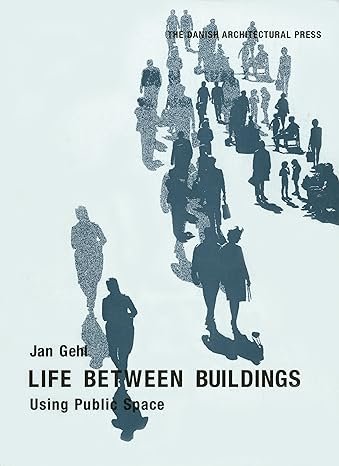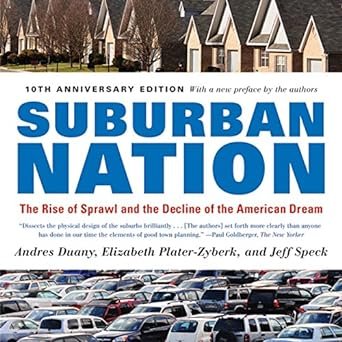
Learn with us.
In the hopes of empowering our community with the tools to drive meaningful change, we’re sharing educational resources with you, including the history of Fondren, as well as insight from visionaries, leaders, and authorities in the areas of community planning, urban design, and placemaking. Check out the works of these folks to find innovative thinking and aspirational precedents that we can follow, and let us know what you think makes sense for Fondren wihtin our unique historical and cultural landscape.
Book Club
Some of our favorite books on some of our favorite topics. Links for purchase are provided on each book for online buying with most of these products available through our friends at Lemuria.
The Death and Life of Great American Cities has, since its first publication in 1961, become the standard against which all city planning endeavors in that field are measured. Charming, compassionate, beautiful, and bracingly indignant, Jane Jacobs's monumental work provides an essential framework for assessing and understanding the vitality of all cities and neighborhoods.
By helping us better understand the larger public life of cities, Life between Buildings can only move us toward more lively and healthy public places. Buy this book, find a comfortable place to sit in a public park or plaza, begin reading, look around. You will be surprised at how you will start to see (and design) the world differently.
There is a growing movement in America to put an end to suburban sprawl and to replace the automobile-based settlement patterns of the past fifty years with more traditional planning principles. Suburban Nation is a lively, thorough, critical lament, and an entertaining lesson on the distinctions between between these two planning ideologies and the drastically different places they produce.
Jeff Speck has dedicated his career to determining what makes cities thrive. And he has boiled it down to one key factor: walkability. But in the typical American city, the car is still king, and downtown is a place that's easy to drive to but often not worth arriving at. In this book, Speck reveals the invisible workings of the city, how simple decisions have cascading effects, and how we can all make the right choices for our communities.
Today we see sprawling cities that are better suited to cars than people. Donald Shoup contends in The High Cost of Free Parking that the demand for parking by drivers is unfortunately eating away at their very quality of life, and he proposes new ways for cities to regulate parking so that Americans can stop paying for free parking's hidden costs.
Rich with new insights from psychology, neuroscience, and Charles Montgomery’s own urban experiments, Happy City reveals how our cities can shape our thoughts as well as our behavior. The message is as surprising as it is by retrofitting cities and our own lives for happiness, we can tackle the urgent challenges of our age. The happy city can save the world-- and all of us can help build it.
Brain Trusts
Some of our favorites organizations and sites thinking about the ways to improve cities, towns, and neighborhoods. Check not only their web content but their socials for invaluable insight.
Strong Towns gives citizens the knowledge and tools to start making our places better today.
Project for Public Spaces champions placemaking to create community-powered public spaces around the world.
Better Block educates and empowers communities to reshape spaces that promote the growth of vibrant neighborhoods.
Missing Middle highlights a time-proven and beloved way to provide housing choice in sustainable, walkable places.
The Congress for the New Urbanism helps create socially just, economically robust, resilient, and people centered places.
NACTO is an association cities and transit agencies exchanging insights and practices to address transportation issues.
The History of Fondren
We’ve always been a little crazy.
In 1817, Mississippi attained statehood, prompting the state legislature to form a three-member commission in 1821 to designate a suitable location for her new capital. The commission selected an inland site in Hinds County, strategically positioned near the state's center, and christened it Jackson. By the 1830s, a thoroughfare extending north from the burgeoning state capital became linked to Canton, the county seat of Madison, earning the name Canton Road, which we now know as Old Canton Road. Approximately three miles north of Jackson, a secondary route veered westward towards Tougaloo Plantation. It was initially dubbed Tougaloo Plantation Road but later assimilated into North State Street. While it would not take shape for many decades, Fondren as we know it ultimately emerged and expanded from this important junction.
In 1833, the area was part of a 5,000-acre plantation owned by the Garland family, as most of the land north of Jackson had been farmed. During the Civil War, the plantation and its holdings were destroyed, and the property was divided amid the Reconstruction Era. Isham Cade, a Black entrepreneur from Carroll County who was formerly enslaved, acquired a substantial portion of land at the fork. His vision was to subdivide the land and offer it for sale to other individuals that had been formerly enslaved and who were looking for places to build their own homes. He divided the land into parcels, had the area surveyed, and began to sell lots, which led to the early growth of a Black community. The focal point of this neighborhood emerged around a collection of houses along "Cade's Alley," which spanned the east-west axis between State Street and Old Canton Road—approximately the location of today's Fondren commercial district.
In 1848, the State of Mississippi initiated the construction of an immense neo-classical "Lunatic Asylum” to the south of Cade’s development. It would emerge as the largest employer in the state and would fundamentally transform the local landscape, spurring rapid growth and evolution within the neighborhood. Capitalizing on the intersection's strategic location, numerous small businesses sprang up, catering to the needs of the community, the hospital, and the increasing number of north-south travelers. A trolley line was established, conveniently connecting downtown Jackson to the hospital and terminating at a turntable near the intersection, directly facing the asylum. To facilitate coal delivery to the asylum, the Illinois Central Railroad constructed a spur line, complete with workshops for the maintenance of their cars and locomotives, while also providing community members with convenient access to incoming supplies and connection to the outside world. At the convergence of these various opportunities, the neighborhood entered a new phase of development, quickly transforming from a residential neighborhood to a bustling village, inviting in a new diversity of people and businesses. The train station, named "Asylum Switch," played a pivotal role in cementing the moniker "‘Sylum Heights" for the swiftly growing and evolving community.
The first Fondren in Mississippi, a pioneer named Richard Fondren, arrived to our great state from South Carolina in 1893, establishing a family farm six miles north of Jackson. Two of his sons, Edward and David Fondren, ventured a few miles south in the same year and established themselves in this region that currently bears their family name. While taking up various business endeavors, David built a wood-frame grocery store at the crossroads of Old Canton Road and North State Street known as David Fondren's General Merchandise and Fancy Grocery that would become a centerpiece of community life in the area.
As the community expanded, the need for a post office arose, and in 1894, one was incorporated into the general store, a common practice of the time. This development designated David Fondren as the community's postmaster— a civic responsibility in which he took great pride. However, the establishment of a post office also necessitated the adoption of a standardized name for the town for postal communications. Not enthusiastic about Asylum Heights as their official name, residents petitioned the U.S. Postal Service to designate the station as 'Fondren.' This decision bestowed upon the community the name it bears today, and for nearly three decades, a sign on the post office proudly identified the area as “Fondren, Mississippi.” The post office building on Fondren Place stands approximately one hundred yards north of the original store site.
By the early 20th Century, Fondren was becoming a well-established community, supporting commercial ventures such as restaurants, drugstores, and hardware stores. The city of Jackson to the south was growing as well, and experiencing northward pressure. As a result, in 1925, the city annexed the Fondren area. It was the first time that a developed community would be included in a Jackson annexation. By 1928, this growing neighborhood of Jackson would require its own school, so Duling Elementary was constructed in Fondren. The school was named in honor of Lorena Duling, a revered teacher within the Jackson school system. It opened with five teachers and 36 enrolled students.
In 1935, a new state mental hospital was constructed fifteen miles to the south of Jackson at Whitfield, and most of the old asylum structures were demolished The Fondren community, now well established and racially diverse, was able to continue without the original organizing focus of the hospital, but the demolition would eventually make the way for construction of the four Fondren area hospitals we see today.
Riding the move theater boom of the era and welcoming much-needed entertainment options to Fondren, The Pix Theater, now known as the Capri, was built in 1939. It was the first Jackson theater to locate outside of the downtown area and featured the innovative Art Deco style which would ultimately help to influence a number of similar designs in the area. The theater was also the first in Jackson to showcase wall-to-wall drapery, Xenon lights, and rocking chairs.
In the 1940s, Fondren underwent significant transformations following the conclusion of World War II. The post-war building surge, economic prosperity, and a substantial uptick in car ownership rendered obsolete the once necessary small lots near the trolley line. This shift allowed for more expansive estate-sized planning, exhibited by the formation of neighborhoods like Woodland Hills. Reflecting these changing dynamics, the Morgan Center, now known as the Woodland Hills Shopping Center, debuted in 1946, including Jitney Jungle and Brent's Drugs. As Jackson's first "shopping center," it embraced a novel concept that accommodated the new car culture, situating retail stores behind surface-level parking lots for the first time. The architectural design of the complex embraced the Streamline Moderne style, a later iteration of Art Deco characterized by the curving forms and horizontal lines of the ocean liners and trains of the time. Construction on War Veterans Memorial Stadium began in early 1949 and it opened in 1950 with a seating capacity of 21,000. Mississippi Veterans Memorial Stadium, as we know it today, would undergo many expansions before it would reach its present-day size and capacity. In the late 1940’s and early 1950’s, post-war growth significantly contributed to the expansion of new housing options and notably increased the Fondren population.
Jackson’s first suburban “high-rise” office building, the Dale Building, was erected in Fondren in 1956, where the current Fondren Corner development exists. Additional shopping, banks, gas stations, barber shops, restaurants, and churches were added to the mix. The neighborhood continued to be quite racially diverse until the late 1950’s, when rising property values would slowly push some of the Black residents out of the area.
By the 1980’s, the neighborhood was being abandoned to the new “estate lots” of suburban bedroom communities. The flight resulted in a reduction of owner-occupied housing in west Fondren. The concerns on the part of long term Fondren residents led to the organization of a neighborhood organization now known as Fondren Renaissance Foundation (FRF). The boundaries included a relatively diverse— socially, economically, and racially— area of about 2,500 residents and 200 shops. A private, voluntary tax base was created, and neighborhood security was organized. FRF bought thirty rental houses that we rehabilitated and resold to new owners the first year, and the state’s first urban main street program was instituted.
For years, Fondren had affectionately dubbed its central cluster of businesses comprised galleries, retailers, and restaurants—a historic district. Thanks to the collaboration with the Mississippi Department of Archives and History and a generous development group, the cherished designation was formally recognized on September 10, 2014, when the "Downtown Fondren Historic District” received official recognition by being named to the National Register of Historic Places.
Today, Fondren stands as a thriving and beloved cultural center within Jackson. While David Fondren's grocery store closed its doors in 1953, the Fondren community, continues to bear his name, paying homage to one of its first commercial tenants and a man fondly remembered as a community leader who ardently supported Fondren. He was remembered for the way he warmly spoke to all of his customers and carried their groceries out to their cars, even well into his old age. While it may not bear his name, the success of the community also owes much to Isham Cade, a key figure in Fondren's development. Cade, with his hands-on approach, passionately believed in constructing a neighborhood for his community, embodying the American dream and a classic entrepreneurial spirit. These two exceptional individuals, driven by an optimistic and steadfast commitment to community as well as a desire to leave a legacy for both Black & White residents alike, creatively shaped the neighborhood’s identity and culture, establishing the enduring values that make Fondren what it is today.
Illustration of Isham Cade
Postcard showing the Mississippi Lunatic Asylum
A young David Fondren
The first Fondren Grocery located on present day Fondren Place and showcasing a small "Fondren, MISS" sign, circa 1925
The second Fondren Grocery located on State Street
Marion Fondren working the register and phone at Fondren Grocery
An older David Fondren
Early years on "The Strip"
A newspaper article at the time of David Fondren's death, lovingly noting Fondren as an "unusual man"
The 1946 blueprints of Jitney Jungle showing its Art Deco flair
A postcard of Veterans Memorial Stadium
A 1956 newspaper article, noting Fondren's "unusual" character
How to Make Cities that People Love
On February 15, we hosted a virtual lecture about the fascinating history of city and neighborhood design in America, and what we principles we can learn from it in order to shape the future Fondren into a more well-rounded and beloved community. It’s an in-depth discussion for those who want it, so grab some popcorn and get comfortable!























